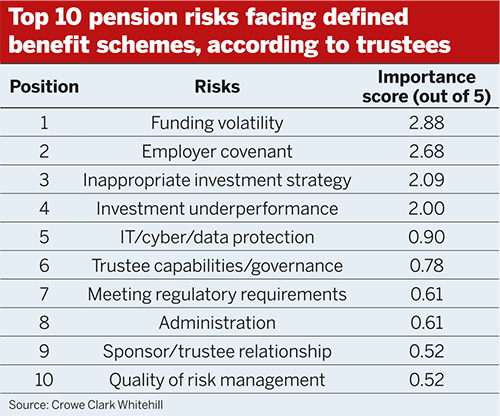As covenant risk moves up defined benefit scheme trustees’ agendas, what is the best way to keep tabs on an employer?
“Of course it doesn’t,” the chief executive officer of covenant specialists Lincoln Pensions says. “DB schemes continue to run very substantial amounts of risk in delivering the benefits. The accounting measure is a consistent but relatively weak funding measure... and many accounting deficits or surpluses grossly misrepresent the extent of the pensions issue.”
One of the warning signals to watch for is the nature of the dialogue you have with the sponsor
Darren Redmayne, Lincoln Pensions
Indeed, if the DB headlines of recent months have taught us anything, it is that funding levels are but one factor when determining a scheme’s chances of success.
For example, the insolvency of Toys R Us shortly after agreeing a company voluntary agreement to separate its DB scheme showed the industry that the underfunded liabilities were not merely an actuarial phenomenon hamstringing an otherwise healthy business.
Instead, it hammered home the importance of a strong covenant – having an employer that can stand behind the scheme at least as long as benefits that will be paid perhaps 50 years in the future.
Complacency in the corporate sector
The good news is that trustees are becoming increasingly aware of covenant risk and are trying to tackle it. Covenant advisers report an increased number of clients, with schemes considering them as important as their actuary or investment consultant.
Less comforting is the evidence of deterioration of covenant within some sectors of UK commerce.
“I’m seeing behaviours in the market that I last saw in 2007,” says Redmayne. That is not to say we are heading for a financial crisis, he cautions, but it highlights a complacency in the corporate sector.
Corporate activity and levels of debt have spiked, and “the leveraged transactions that we’re seeing involving private equity are at leverage levels that I haven’t seen since the period immediately prior to the financial crisis”, he says.
Trustees are limited in their formal power to block corporate activity or even dividend policies that might weaken their employer covenant.
“The struggle that trustees face is that their agreement is not needed,” regarding these types of actions, “so companies can pay dividends to shareholders without going to the trustees first”, says Matthew Swynnerton, partner at law firm DLA Piper.
Of course, the checks on employer actions in the UK are provided by the Pensions Regulator, but Swynnerton notes that, at least until the introduction of the pensions watchdog’s “clearer, quicker and tougher” stance, companies have become more complacent.
“There have been relatively few contribution notices or moral hazard sanctions… people have grown more confident, certainly in an M&A context,” he says.
Maintaining good relations with the sponsor
That said, in practice trustee boards do have some tools at their disposal. Guided by the integrated risk management framework, trustees are within their rights to reduce the investment risk in the scheme to compensate for a weakening of covenant.
Communicating the resulting increased cash demands in a constructive way can therefore afford trustees some leverage over the employers.
However, this should be viewed as a “nuclear option”, given the potential for relationships to sour, says Swynnerton.
“Trustees are always at pains to try and maintain good relations with the employer where they can and so I think many would be loath to do something like that,” he says.
This spirit of collaboration should be evident in the way trustees balance their derisking strategies with the needs of their employer – Redmayne sees many schemes agreeing funding plans with reduced short-term cash calls while investment in the business takes place, forming a “hump” of funding.
Keeping tabs on the employer
Meanwhile, Simon Kew, director at Deloitte, points out the persuasive argument that trustees can make for employers granting contingent funding or guarantees.
“You can then improve the covenant, which means the technical provisions funding target comes down, which means the trustees can be a little bit more adventurous,” he says. “I’m not a great fan of trustees focusing purely on cash.”
Of course, for a board to be vigilant against any deterioration of its covenant, it has to monitor the strength of its employer.
Beyond the rather obvious point that hiring a covenant adviser might help trustees do this, there are a number of steps that boards can take themselves to keep tabs on their employer.
“There are things they [trustees] can actually do without going to their covenant adviser,” says Kew. For example, trustees of schemes belonging to listed companies can gauge from the investor relations site “whether they’re acquisitive or whether they’re looking for a safe haven, for someone to come in and buy them”.
Often, trustees are uniquely well placed to understand the health of their sponsor, having worked there for years and with a good understanding of the trends at play in their sector.
If they are keen to carry out a more formal monitoring process themselves, particularly if they have budget constraints, they might ask a covenant adviser to pick key metrics to track when they undertake a triennial valuation, according to Tom Lukic, a director at Dalriada Trustees.
They can then ask their finance director to fill in a spreadsheet of these indicators, and score them according to a red, amber and green system. Failing that, they should just ask their finance director to talk them through the business at a high level.
“If you speak to most CFOs, they’ll have four or five key risks,” says Lukic. “I don’t think being small exempts you from being required to monitor your covenant.”
If the level of information sharing breaks down between trustee board and employer, there may be cause for concern.

Conduct premortems to identify risks
“One of the warning signals to watch for is the nature of the dialogue you have with the sponsor. If you’ve had a reasonably open and transparent relationship where information has been shared and... that changes and information is not being shared or there are delays, that can be an indicator that there are some challenges ahead,” says Redmayne.
Of course, the directors may just be focused on a deal and anxious not to reveal sensitive information. However, given the potential threat highlighted by Redmayne as well as regulatory pressure, trustees are leaning on their advisers to navigate these tensions for them.
“I no longer see covenant monitoring as optional, I see it as the regulator saying it is a requirement,” says Lukic.
With the Pensions Regulator stressing the importance of integrated risk management and declaring itself “clearer, quicker and tougher”, that should at least give trustees some recourse if their efforts at collaboration are rebuffed by the employer.
“Trustees can remind employers that they have a statutory obligation to disclose on request to the trustees ‘such information as is reasonably required for the performance of the duties of trustees or managers or professional advisers’,” says Vicky Carr, a partner at pensions law firm Sackers.
“If that does not do the trick, trustees could seek to involve TPR, which has information gathering powers – the DB white paper stated that those powers will be strengthened,” she adds.
It might be tempting for a board with a strong covenant and a good relationship with their employer to ignore these worst-case scenarios, in the belief that this is unlikely to befall them.
But doing so risks being dangerously underprepared, says Redmayne, arguing that all schemes should conduct theoretical “premortems” to identify the key risks.
“People rarely see the gun that kills them,” he says. “The regulator expects trustees to contingency plan and to contingency plan properly. Covenant is arguably the biggest risk exposure over the long term schemes have.”














